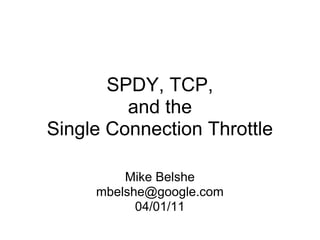
SPDY, TCP, and the Single Connection Throttle
- 1. SPDY, TCP, and the Single Connection Throttle Mike Belshe mbelshe@google.com 04/01/11
- 2. A New Protocol? What for? Speed.
- 3. State of the Web Page An average Web Page Consists of: ~44 resources ~7 hosts ~320KB ~66% compressed (top sites are ~90% compressed) Note: HTTPS is < 50% compressed. Incremental improvements to HTTP don't move the needle Transparent proxies change the content. Example: pipelining Example: stripped "Accept-Encoding" headers we can't even improve "negotiated" compression!
- 4. Quick SPDY Background Goals: Faster web page downloads Always secure Deployable Open Features (No rocket science here!) Single-connection, Multiplexed, prioritized streams Mandatory header compression Supports server-push SPDY is Basic Networking "blocking and tackling" Use fewer connections Send fewer bytes
- 5. HTTP Connection Use Today Average: 29 connections per page. 25%-tile = 10 50%-tile = 20 75%-tile = 39 95%-tile = 78
- 10. The Single Connection Throttle
- 11. Throttle #1: CWND Problem: Server-side slow start limits server to N packets. (in flux) Workaround: Use more client connections. Update server to go beyond spec. SPDY can use a cookie based cwnd. Note: HTTP's per-domain cwnd is currently ~24 (6*4). draft-ietf-tcpm-initcwnd-00.txt helps
- 12. Throttle #1 CWND vs # connections
- 13. Throttle #2: Receive Windows Problem: Some clients set initial rwnd to 5840 bytes (4 pkts) Trumps larger cwnd on servers. Patch just shipped this month in linux mainline Workaround: Use more client connections.
- 14. Throttle #2: Init rwnd
- 15. Throttle #3: Intermediaries Problem: "Just a bug"... but... Intermediaries can (and do) tamper. window scale enables large receive windows. Workaround: Use more client connections. Client Side Server Side // Client wants window // Server recvs window // scaling 6. // scale 3. Someone // tampered with this. SYN -> w=5840, ws=6 SYN -> w=5840, ws=3 // Client receives server // Server sends its own // ws as sent. // ws of 6. SYNACK <- w=5840, ws=6 SYNACK <- w=5840, ws=6 // going to be slow....
- 16. Throttle #4: Congestion Control Problem: Congestion detection decreases the send rate. But congestion signals can be erroneous. Applied to the connection, not the path: 1 connection: single packet loss cuts send rate by N (typically 0.5/0.7). 6 connections: single packet loss cuts send rate by 1/6*(1/N) == (~1/9th to 1/12th) Workaround: Use more client connections.
- 17. Too Obsessed With 1 Connection? Could we use 2? 3? Sure, but it neutralizes many of our benefits. Disadvantages of multiple connections: Sharing state across connections is hard. Server farms would be required to do sticky load balancing Compression worsens (we use stateful compression) Prioritization becomes impossible Server push difficult But it shouldn't be this hard...
- 18. How Much Does A Handshake Cost?
- 19. What's Next? Before SPDY, we could blame the app layer (HTTP). With SPDY, we're on the verge of proving that the transport is the new bottleneck. TCP needs to address 2 performance obstacles: Data in initial handshake. Single connection taxes. TCP needs to address security Both Server Auth & Encryption (Sorry I didn't have time to discuss in this talk!) How can we iterate on the transport when it is buried in the kernel? Can we auto-update the network stack?
